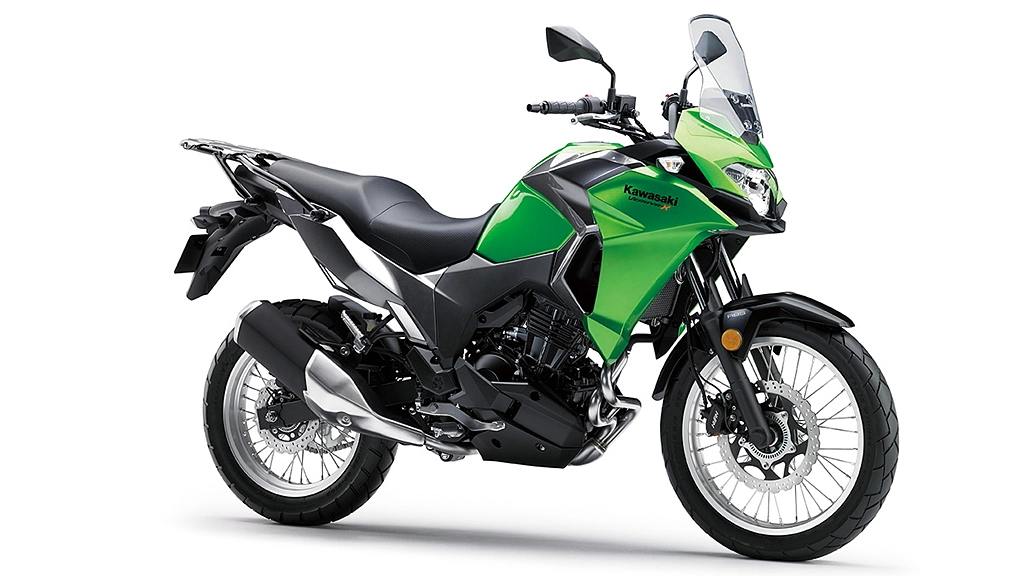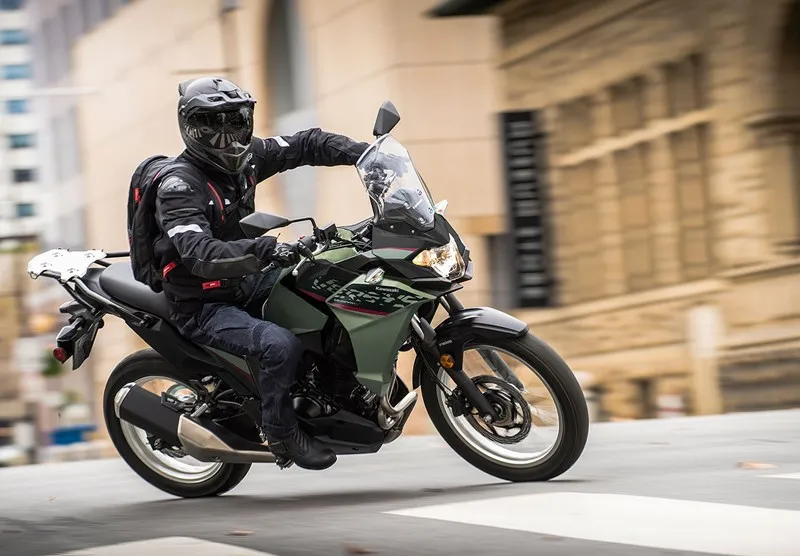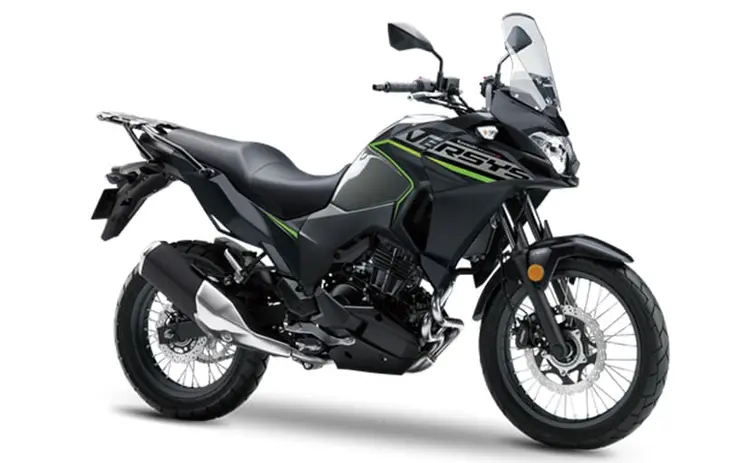To many riders, mini adventure bikes make a lot of sense. A2-legal and boasting upright and comfortable riding positions, bikes such as the Suzuki V-Strom 250, KTM 390 Adventure and Royal Enfield Himalayan are tempting prospects – even more so when you add in their frugal economy figures and ability to take to the green lanes for a bit of weekend amusement. In 2017 Kawasaki got in on the mini adventuring act with the Versys-X 300, a bike that unlike the rest of the Versys family, actually came with some off-road pretentions through a 19-inch front wheel rather than 17-inch wheels like the 650 and 1000.
Powered by the Ninja 300’s excellent parallel twin engine, the Versys-X should have been a good seller for the firm but oddly it wasn’t and where the likes of the Enfield and KTM have gone on to great things, like the V-Strom 250 the Versys-X had a short lifespan in the UK of just two years. Does that mean it is a bike to avoid? Not necessarily and if you are after a solid plodder that can commute or explore the occasional muddy green lane, the Versys-X isn’t a bad option and is quite well priced in the used market.
Kawasaki Versys-X 300 Price
The Versys-X cost £5149 in standard trim in the UK or £5899 for the Adventure version, which added panniers, a centre stand, hand guards, engine guards and a tank pad, and £5549 for the Urban with its top case, hand guards, centre stand and tank pad. Nowadays you are looking at paying just under £3000 for a standard bike (probably with a top box) in a private sale with dealers asking for around £3500 for a well-used (approaching 10,000 miles) bike or £4000 for one with less than 5000 miles on its clocks. In comparison, prices for a 2018 V-Strom 250 start at £3000, a 2020 KTM 390 Adventure will set you back £4500 and you need to find about £3500 for a 2019 Himalayan.

Must Read: TVS iQube Price – Range and Reviews
Engine, gearbox and exhaust
Due to the fact that Kawasaki wanted to give the Versus-X some off-road potential, they took the decision to arm it with a 46-tooth rear sprocket, up three teeth on the Ninja 300’s sprocket yet with the same internal ratios. While this certainly makes it pull stronger at low revs, which is handy in the mud, on the road it makes it really rev-happy and when you are doing 60mph the engine feels and sounds like it is working far harder than it needs to be.
A change of rear sprocket (or front) helps cure this and is a great idea if you only ride on the road as it would also boost the economy figures even further, but in standard trim it is annoying as the Ninja’s parallel twin motor isn’t really a rev-monster. Onto more positive things and the slip & assist clutch’s action is feather light, the fuelling decent and economy figures impressively high.
So what’s not to like? In terms of the motor, not a lot. The Ninja 300’s engine has a very solid reputation for reliability as long as it is serviced regularly (every 3800 miles with valve clearances at 7600 miles) it can take a heck of a lot of abuse and is cheap to get serviced with even the big service only costing about £300 and the minor half this. And if you want to do the oil change minor service at home, parts are less than £40. As you would expect on a budget bike the fasteners and finish can be a little poor in areas but the exhaust is stainless steel, which is good news, and the paint on the engine and exhaust seems quite well applied and fairly resistant to flaking.
Kawasaki Versys-X 300 Economy
Kawasaki claimed the Versys-X could do 66mph and record over 200 miles from its 17-litre tank, which is really impressive and a claim backed up by owners with a few even getting it up to 70mpg. Put the taller gearing on and you could even see 80mpg, which certainly isn’t to be sniffed at. Consumable parts are cheap and plentiful and insurance is also next to nothing, making the Versys-X a very cheap bike to run if you are on a tight budget.
X 300 (2017-2019) Brakes
The Versys has a pretty common two-piston sliding caliper front brake and a rebuild kit is only £25, so you don’t need to be too worried if it is a bit corroded. The chances of a disc wearing thin are minimal and the rear caliper is also cheap to rebuild. Not the most powerful of braking set ups, the Versys’s stoppers are adequate but in all honestly, with a skinny front tyre and soft forks that is about all you need. ABS was an option and most UK bikes come with it. Annoyingly the ABS can’t be disabled for off-road use without removing a fuse.
Comfort over distance and touring
Kawasaki did their best to make the Versys-X a fairly practical bike and as well as the large 17-litre tank they gave it a big screen, wide fairing, roomy riding position and a decent sized seat with a rear luggage rack as standard. However it isn’t all good news because the seat isn’t very comfortable and the motor’s vibrations make it a bit irritating to ride big distances on. A better seat and a change to the gearing makes it far more accomplished at mile-munching but you are still on a fairly small bike so it is limited in its use as a tourer.

Rider aids and extra equipment / accessories
Aside from the option of ABS (which can’t be disengaged) the Versys-X has no rider assists unless you count the gear indicator, fuel gauge and ‘eco’ warning light on the dash. In terms of accessories, however, Kawasaki really did push the boat out. The Versys-X was sold in Adventure spec (which added panniers, a centre stand, hand guards, engine guards and a tank pad) or Urban (which added a top case, hand guards, centre stand and tank pad) but most UK bikes are standard spec. All of the parts were available separately alongside additions such as fog lights, brush guards, top box and taller screen. As the Versys-X is popular in other regions, you can still buy a good lot of accessories and taller screens, heated grips, aftermarket shocks, lower seats, comfort seats etc etc are very easy to obtain.
Kawasaki Versys-X 300 (2017-2019) spec
| Original price | £5149 |
| Current price range | £2700-£4300 |
| Capacity | 296cc |
| Bore x Stroke | 62x49mm |
| Engine layout | Parallel twin |
| Engine details | DOHC, 8v, liquid-cooled |
| Power | 40bhp (29.3kW) @ 11,500rpm |
| Torque | 19 lb-ft (25.7Nm) @ 10,000rpm |
| Top speed | 80mph |
| Transmission | 6 speed, chain final drive |
| Average fuel consumption | 66mpg |
| Tank size | 17 litres |
| Max range to empty (theoretical) | 200 miles |
| Reserve capacity | 34 miles |
| Rider aids | ABS (optional) |
| Frame | Steel backbone |
| Front suspension | 41mm telescopic forks |
| Front suspension adjustment | None |
| Rear suspension | Monoshock |
| Rear suspension adjustment | Preload adjustable |
| Front brake | 1 x 290mm petal disc, two-piston caliper. ABS optional |
| Rear brake | 220mm disc, one-piston caliper. ABS optional |
| Front tyre | 110/90 – 19 |
| Rear tyre | 130/80 – 17 |
| Rake/Trail | 24.3° / 108mm |
| Dimensions | 2170mm x 860mm x 1390mm (LxWxH) |
| Wheelbase | 1450mm |
| Ground clearance | 180mm |
| Seat height | 845mm |
| Kerb weight | 175kg (wet) |
DRIVETRAIN | ||
| Clutch | Wet multi-disc, manual | |
| Transmission | 6-speed, return shift | |
| Final Drive | Chain | |
CHASSIS | ||
| Suspension Front | ø41 mm telescopic fork / 130 mm (5.1 in) | |
| Suspension Rear | Bottom-Link Uni Trak, gas-charged shock with adjustable spring preload / 148 mm (5.8 in) | |
| Brakes Front | Single ø290 mm petal disc with balanced actuation dual-piston caliper | |
| Brakes Rear | ø220 mm petal disc with dual-piston caliper | |
| Tires Front | 100/90-19M/C 57S | |
| Tires Rear | 130/80-17M/C 65S | |
| Fuel Tank Capacity | 17 litres | |
| Color | Metallic Ocean Blue/Pearl Robotic White | |
ELECTRICAL | ||
| Ignition | TCBI with digital advance | |
| Spark Plugs | ||
| Headlight | LED | |
| Tail Light | LED | |
DIMENSIONS | ||
| Overall Length | 85.4 in | |
| Overall Width | 33.9 in | |
| Overall Height | 54.7 in | |
| Wheelbase | 57.1 in | |
| Ground Clearance | 7.1 in | |
| Seat Height | 32.1 in | |
| Curb Weight | 175 kg (386 lb) | |
WARRANTY | ||
| Warranty | 12 Months | |
| Kawasaki Protection Plus | 12/ 24 / 36 / 48 months | |
X-300 Summary
Kawasaki Versys X-300 is an adventure tourer motorcycle from the Japanese manufacturer. The motorcycle is yet to receive a BS6 upgrade. The old model, for reference, used a 296cc parallel-twin motor that produced 38.5bhp and 27Nm of torque. Do note that the Versys X-300 shares its engine with the Ninja 300, and the latter has already received the necessary changes to comply with the newest emission norms.
In terms of design, the Versys X-300 will feature a single-pod headlight at the front, a semi-fairing, a tall windscreen, a step-up saddle, and a side-slung exhaust. Being an off-road focussed motorcycle, the Versys X-300 used wire-spoke wheels that were wrapped in tube-type tyres. The feature list on the motorcycle includes a halogen headlight at the front and a semi-digital instrument cluster.
The hardware on the motorcycle comprises telescopic front forks and a rear mono-shock to handle the suspension tasks. The braking tasks are handled by single discs on both wheels while the safety net includes a dual-channel ABS.
Also Read: activa 7g launch date
Conclusion
The Kawasaki Versys-X 300 offers a compelling option in the mini adventure bike segment, with its A2-legal status, upright riding position, and off-road capabilities. Despite its short lifespan in the UK market, it remains a viable choice for riders seeking a versatile and budget-friendly machine. While its engine’s gearing may feel rev-happy on the road, it boasts solid reliability and impressive fuel economy. The bike’s comfortable ergonomics, ample accessories, and practical features like a large fuel tank make it suitable for commuting and occasional off-road excursions. However, its seat comfort and vibration levels on long rides may be limiting factors for some. Overall, with its affordable pricing in the used market and potential for customization, the Versys-X 300 presents a compelling option for riders seeking an entry-level adventure bike experience.




